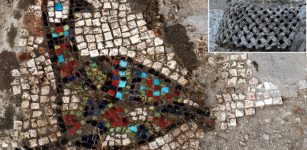Seven 1,600-Year-Old Arjai Grottoes With Frescoes – Restored
Conny Waters - AncientPages.com - The 1,600-year-old Arjai Grottoes - also known as the Baiyanyao grottoes - have been under restoration since August 2018. Out of the 65 grottoes at the site, 43 caves are painted, and 41 have remained intact, with 14 of them featuring frescoes.
Studies showed that they were constructed between the Northern Wei and the Ming.
 Photo taken on Sept. 4, 2018, shows murals inside Arjai Grottoes in Otog Banner of Ordos, north China's Inner Mongolia Autonomous Region. source
Photo taken on Sept. 4, 2018, shows murals inside Arjai Grottoes in Otog Banner of Ordos, north China's Inner Mongolia Autonomous Region. source
"The frescoes of the Arjai Grottoes, which mostly depict themes of the Western Xia Dynasty (1038-1227) and the Yuan Dynasty (1271-1368) in Chinese history, have decayed after long-term exposure to wind and rain, so the restoration is urgent," according to a grotto researcher Wurigaqolu.
However, a program to restore the frescoes of the 1,600-year-old Arjai Grottoes continues and now, seven grottoes featuring frescoes have been restored in the city of Ordos, north China's Inner Mongolia. Autonomous Region, reports China Daily.
 Photo taken on Oct 18, 2019, shows the relief of the Arjai Grottoes of Otog Banner in Ordos, North China's Inner Mongolia autonomous region. Image credit: Xinhua
Photo taken on Oct 18, 2019, shows the relief of the Arjai Grottoes of Otog Banner in Ordos, North China's Inner Mongolia autonomous region. Image credit: Xinhua
"The number of the Yuan Dynasty frescoes is quite limited in the country, so the restoration carries significance in history, art, and culture."
Local authorities have also taken pictures of the frescoes so as to preserve them in a digital form.
The Arjai Grottoes, home to nearly 1,000 frescoes related to Tibetan Buddhism, are located on a hill in the grasslands of Otog Banner, Ordos City, along with other ancient structures including temples and palaces, that have been protected since 2003.
The site is also the largest cave temple complex in Inner Mongolia, and according to Chinese archaeologists contains numerous Buddhist murals.
It is also claimed that Genghis Khan (1167-1227) based his sixth expeditionary force to the Western Xia regime in 1226 in Otog Qi (county) in Ordos, a city of North China's Inner Mongolia autonomous region.
Genghis Khan's main force was located in Arjai Grotto of Otog Qi where he recovered from injuries. The area has more than 80 deep wells every 10 meters apart are located 20 km to the east of Arjai. These wells - according to tradition - provided water for the Genghis Khan's tens of thousands of soldiers and horses.
Written by Conny Waters - AncientPages.com Staff Writer




















